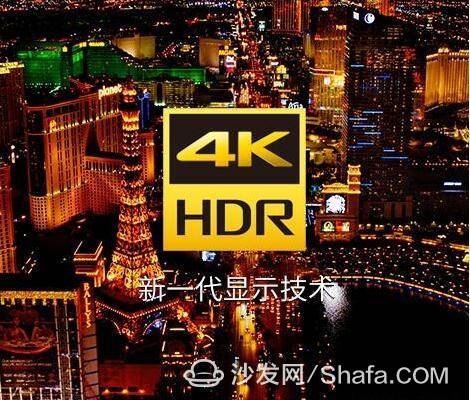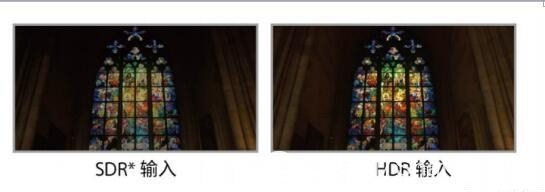
When it comes to HDR display technology, it is not really a new technology. In the field of digital photography, the term has long been known to everyone, and in the field of display, HDR technology has only begun to rise in recent years.
The so-called HDR, its full English called High-Dynamic Range, translated into Chinese for high dynamic range images, compared to ordinary images, can provide more dynamic range and image details, according to different exposure time LDR (Low-Dynamic Range) In the image, the final HDR image is synthesized using the LDR image corresponding to the best detail for each exposure time, which can better reflect the visual effect in the real environment.
Popularly speaking, HDR technology increases the brightness range, while increasing the contrast of the brightest and darkest pictures, thereby obtaining a wider range of colors, in addition to significantly improve the grayscale, but also brings a darker or more white color effect. In this way, the user can see more details in the screen, of course, provided that the video resources being played also support HDR technology.

With the trend of 4K home projectors becoming more and more hot in these two years, the 4K concept undoubtedly penetrated the heart of many movie fans, and it also made some enthusiasts crazy. However, enthusiasts have encountered a problem, that is, although the resolution of 4K ultra high-definition has been significantly improved, but the overall picture of the depth of field is still a little lacking, especially as a projector projecting hundreds of inches above the home screen What really makes the user feel intuitive is HDR.
It can be said that HDR is part of the overall planning of Ultra HD projectors. In sync with HDR's high brightness range display, there will also be a higher color depth and a larger color space range. The higher the color depth, the more colors that can be supported. The increase of color depth not only increases the gray value of the image, but also makes the visual transition of the same color system smoother, avoiding obvious stratification when expressing the gradient color.
At the same time, with the new generation of ultra-high-definition specification ITU BT.2020, the color range will be 70% more than BT.709, especially in the three high-brightness areas of green, yellow, and blue. In the HDR standards that have now been released, color depth and color space have been specified accordingly. These parameter enhancements together bring about a "better pixel" display.
For this reason, from the beginning of last year, more and more HD projectors have been added to 4K home projectors to enhance the high-quality texture. However, in the home theater market, HDR is still a new technology, and the industry has not yet set standards, resulting in uneven technology. In general, standards are the recognition of faits accomplis. Therefore, technology-leading companies often have a great deal of voice in the standards and will also be the biggest beneficiaries after the standards are established.
Sony led the industry and launched the world’s first native 4K home theater projector VPL-VW528 with HDR high dynamic range capability in 2015, which can bring more realistic images. This is also Sony. Following the release of the world’s first flagship native 4K home theater projector in 2012, it continues its extraordinary visual and audio experience for home theater users.

With the continuous advancement of Sony's technology research and development, the HDR function has gradually been applied to Sony 4K home theater projector products as a standard, it brings a more level of contrast between brightness and darkness, making the night scene closer to the actual human eye observation. Based on the HDR function, the biggest difference between the new HDR home theater projectors supporting 2016 and the predecessor models is that users can freely adjust the screen brightness in the HDR mode according to the ambient brightness to make the viewing experience more comfortable. This function became the first of Sony's successor to the true 4K chip, and once again led the market in a similar way.
This year, Sony once again upgraded its product line of home theater projectors, bringing with it new HDR 4K home theater projectors, such as the VPL-VW268 and VPL-VW368, which have just been released. This brings a contrast of brightness and darkness. Makes the night scene closer to the actual human eye observation effect. And another new laser 4K ultra-short focus projector VPL-VZ1000 for the living room theater, also supports HDR function, whether it is in 4K 24 frames or 4K 60 frames can be achieved, its delivery screen has extremely Realistic clarity, the details are in perfect condition.
In addition, according to the author's understanding, Sony's new midrange 4K home theater projector new VPL-VW768 (when the article was released, or has been released in the country), will also join the HDR function, will allow audio and video fans to experience more impact The viewing screen. Sony also offers one-stop HDR 4K home projector solutions for different levels of users.
And unlike other brands, Sony has always been very focused on image quality performance. It also does not use other brands as a simple technique to upgrade HDR technology in the original parameters. Instead, it uses HDR and Sony's unique quality display technology: It enables deep integration of Triluminos Display technology, Motionflow technology, and native 4K SXRD panels with a wider color range, achieving a 1+1>2 linkage effect and maximizing the effect of HDR content.
Moreover, as more and more HDR television, the problem is transferred from the consumer to the content creators: the hardware is there, but not what to see, especially in the home theater market. Moreover, compared with TV manufacturers, there is very little that the projector industry can produce HDR content. The perfect compatibility of content and hardware is also a problem, and it may not be able to achieve original HDR content.
Sony undoubtedly opened up this closed loop and has already formed a complete production process. It is understood that a new Sony project is expected to solve the problem of lack of HDR content resources. The company plans to provide users with HDR movies, online video and even live video. This undoubtedly brings rich resources for HDR home projectors, and the two are also perfectly compatible with each other. At the same time, it also demonstrated Sony's powerful strength and practical solutions, leading the development of HDR technology.
HDR is an inevitable product of the development of the display industry. Just like the once 1080P Full HD and 4K Ultra HD, it is the constant evolution of display quality. Sony's HDR technology has taken the lead in the home theater projector market, and its strength is unmatched by other brands in the projector market. Sony has demonstrated its powerful strength and practical solutions from HDR program shooting, live production to monitoring, home and public display, leading the development of HDR technology. At the same time, this is also Sony's laser and 4K “spokesman†in the projection market, the next step is to be the HDR technology pave the way, or will lead the home theater projector market voice.
Smart TV/box information can focus on smart TV information network sofa butler (http://), China's influential TV box and smart TV website, providing information, communication, TV boxes, smart TVs, smart TV software, etc. Answering questions.Disposable Vape,Disposable Vape Flavours,Disposable Vape Fume,Disposable Vape Flum
Lensen Electronics Co., Ltd , https://www.lensenvape.com
